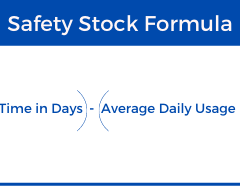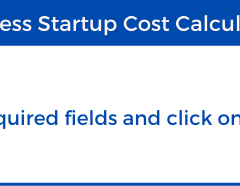01 Dec

What is Break-Even Analysis and Break-Even Point Calculator?
Break-even analysis is a method to calculate the break-even point of an enterprise. Break point is an even point where the total cost is equal to the total revenue, therefore, neither profit nor loss incurred on a particular number of unit sales. Using break-even point calculator, consider Fixed cost, Variable cost per unit, and selling price per unit.
Break-even point calculator is helpful when you want to know the number of units you need to sell to reach the breakeven point.
For example, you are producing a new range of items to sell. To cover your fixed and variable costs through sales, you need to calculate the break-even point or the number of units you will need to sell to meet TC = TR.
Learn more about Break-even Analysis ->
What are Fixed costs?
Fixed costs are the costs that have to be incurred even when there is less or no production. It does not depend on the level of production or the number of units sold.
Some examples of fixed costs comprise rent, machinery expense, salaries and wages, insurance premium, and so on which you can use in break-even point calculator. You notice that all the costs on these items do not change even is you increase the production or sales amount per month.
What are Variable costs?
Variable costs are the cost that increases or decreases with the production and sales. Therefore, variable costs directly relate to the level of production and sales in the market. VC will be Zero if the production is Zero. Variable costs are the usually calculated on the per unit basis. It will increase with the increase in sales and decrease with the decrease in sales.
Some common examples of variable costs include delivery charges, commission, temporary workers’ wages, production supplies, freights, and so on which you can use in break-even point calculator.
Learn more about Fixed and Variable costs ->
What is the formula used in break-even point calculator?
The break-even point calculator is on the basis of Unit of sales volume. Therefore, the amount of units a firm should sell to gain the break-even point.
Formula –
BEP unit = Fixed cost / contribution per unit
Here, contribution per cost = ‘selling price per unit – Variable cost per unit’

Therefore, this is the formula to calculate BEP in terms of unit sales.
Learn more about BEP Formulas ->
How is Break-Even Point helpful for your business?
The Break-even point is a critical stage in a firm. It is a pathway of an efficient business metrics as it helps the business to design their cost structures such that they cover all their expenditures.
Here are the top 3 reasons break even calculation is a boon to your business.
1. Practicability
It’s critical to know that when you are launching a product, at what time or at what number of sales, the firm will start covering the costs. Therefore, it’s important to study the practicability of the new line product with break-even analysis. Using break-even point calculator, you can easily calculate the number of unit sales needed you cover your total costs and variable costs as per your selling price per unit. This will help you define a set of tasks and strategies to meet the required number of BE sales and make your business more profitable by sticking to a set timeline.
2. Analysis
Variations in business is a natural scenario. It can be a newly set up enterprise, an older firm introducing new products, or any other business which degraded in the past few months. External factors, like trade concessions and variations in the political environment, impact your selling. This may induce your variable or fixed costs to climb. In such situations, break-even point calculator will aid you determine on new prices for your products. The break-even point calculator shows you a definite picture of how much time would your business take to recover any losses and break even again after any change in the business forecast.
3. Strategy
Forming strategies is a crucial part of every organization. No matter what task you have decided, strategies are important at every stage for efficient implementation of your goals. Whether you planning to launch your brand-new product, beat your competitors, or reduce your own costs and expenses, you must have a firm and sound strategy.
To strategies more revenue and low costs, you will need to analyze the break-even point of your product. Using break-even point calculator, you can opt on changes in variables (like depreciation rate, promotional costs), and easily calculate how much unit sales you need to equal total cost and total revenue, i.e., break-even point. This helps you design a more powerful strategy and brings in better advances for your company.
Learn more about benefits of break-even point calculator ->
Break-Even Point Calculation Examples –
For more detail, we have explained few examples to help you give a better understanding so you can use the break-even point calculator efficiently. Before we move towards examples, lets discuss the basics.
Since the basic idea of break-even point is to determine the sales amount at which the revenue exceeds the costs. Therefore, before calculations we must separate the company’s Total Cost (TC) into Variable Costs (VC) and Fixed Costs (FC).
Example 1
Let’s first take an example of a simple calculation. Assume that a company produces and markets a single product as follows:
Selling price per unit = Rs 30
Variable cost per unit = Rs 20
Total fixed cost = Rs 2,00,000
Formula for calculating the Break-Even is = Fixed Cost / Contribution per unit.
- Break-Even = Fixed Cost/ (Selling Price per unit – Variable cost per unit)
- Brea-Even = 2,00,000/ (30-20)
- Break-Even = 20,000 units
Therefore, the break-even sales to cover fixed costs will be 20,000 units.
Analysis
If the company sells over 20,000 units, it will earn profits because fixed costs remain constant. If they cannot achieve this target, they will incur a loss. The profits will be equal to the number of units sold over 10,000 units multiplied by the unit contribution margin. For example, if 25,000 units are sold, the company will operate at 15,000 units above its break-even point and will earn a profit of Rs 1, 50,000 (15,000 units x Rs 10 contribution margin).
Example 2
A company’s income statement for a month is given below. Calculate the break-even.
| Particulars | Amount |
|---|---|
| Sales – 30.,000 units at $80/unit | $240,000 |
| Less: | – |
| Cost of Goods Sold | |
| Variable Costs | $180,000 |
| Fixed Production Costs | $19,800 |
| Gross Margin | $40,200 |
| Less: | – |
| Selling and Administrative Expenses | |
| Variable Costs | $21,000 |
| Fixed Production Costs | $7,500 |
| Net Income Before Taxes | $11,700 |
| No. of Units Produce | 3000 |
| Selling Price per Unit | $90 |
| Variable Costs | $60 |
| Fixed Costs | $26,700 |
Now, lets calculate the break-even output, i.e., number of units needed to sell to attain the break-even point. Break-even point is calculated using the formula specified below:
Break-Even = Fixed Costs / Contribution per unit.
- Break-Even = Fixed Cost / (Selling Price – variable Costs)
- Break-Even= 26,700 / (90 – 60)
- Break-Even = 890
Now if we say, variable costs increased by $5, what will be the break-even point?
An increase in the variable costs by $5 will make variable costs to ($60+$5) $65. Thus, the break-even point will move further.
- Break-Even = Fixed Costs / Contribution per unit
- Break-Even = Fixed Cost / (Selling Price – variable Costs)
- Break-Even= 26,700 / (90 – 65)
- Break-Even = 1,068 units
Therefore, higher costs results in higher break-even point. Similarly, lower costs results in low break-even point. Though, it’s better to keep the break-even as low as possible to cover the losses.
Example 3
Let us now take an example where we will calculate break-even point for multiple products.
Jennifer wants to derive the break-even point for the next year, relying on the below data. As shown below, 50% revenue comes from selling clothes and the remaining 50% comes from selling shoes and bags. They give the respective selling price below :
In the second table, we have variable costs related to each product and the total fixed costs of $65000.
| Product | Price | Proportion to Revenue | Weighted Average 1 |
|---|---|---|---|
| Clothes | 4 | 50% | |
| Shoes | 4.5 | 30% | |
| Bags | 5 | 20% | 4.35 |
| Product | Variable Cost | Proportion to Revenue | Weighed Average 2 |
|---|---|---|---|
| Clothes | 0.6 | 50% | |
| Shoes | 0.7 | 30% | |
| Bags | 0.8 | 20% | 0.67 |
The weighted average is calculated by multiplying each VC and Price with its revenue% and summing up all the values.
Now lets calculate the break-even output using the weighed average price.
- Break-Even = Fixed Costs / Weighed Average (1-2)
- Break-Even = $65,000 / (4.35 – 0.67)
- Break-Even = 17,663 units
Thus, in this way we can calculate the break-even of multiple products. Now the question arises, how to calculate these values on the break-even point calculator?
To do so, we will enter the ‘Weighed Average 1’ in the ‘Selling Price per Unit’ field and the ‘Weighed Average 2’ in the ‘Variable Costs per Unit’ field, keeping the fixed cost value constant. Thus, we can easily calculate the break-even point for multiple products using our break-even point calculator.
FAQs
Q1. How can we reduce break-even point?
Ans. The break-even point should be good to keep as low as possible. We can reduce break-even point by reducing the fixed costs, variable costs, improving sales mix, and increasing prices. However, in realism, it is not that simple to reduce the break-even point. Decreasing fixed costs may undermine a firm’s production capability, while tremendous competition may restrict one from increasing prices. The decisions taken will depend on the factors of both the firm and the market condition.
Q2. Can we calculate Break-Even Point Graphically?
Ans. Yes, we can calculate break-even point graphically. However, using BooksPOS’ Break-Even Point Calculator would be more seamless for you, as graphical plotting requires lots of attention and manual work. You can learn more about graphical calculation here.
Q3. Can we calculate the break-even point in money terms?
Ans. Yes, if we want to calculate the amount of money a firm should spend on sales to attain the break-even point, we can calculate break-even point in money terms as well. Formula for calculating BEP in money terms is, BEP = Fixed cost / PV ratio.
Here, PV ratio = Contribution / Sales. Therefore, the firm can attain the BEP in terms of money value using this formula.
Q4. If the variable costs increases what will be the change in the break-even point?
Ans. If we increase the variable costs, the break-even point will also rise. As variable costs and output are directly proportional, they will behave the same. You can use our Break-even point calculator to calculate the values.
Make It All Easy
If you’re an entrepreneur and are about to launch a new product or any extensive project, the break-even analysis is a great metric to help you estimate the viability of the work. The break-even analysis makes it easy to plan, strategize, and review the progress of the project. However, calculating break-even point manually might be a headache to many entrepreneurs. Not everyone wants to do it manually due to its complexity in calculations. That’s why we created this Free and Ready-to-use Break-Even Point Calculator to solve this hurdle and help you grow more conveniently.







